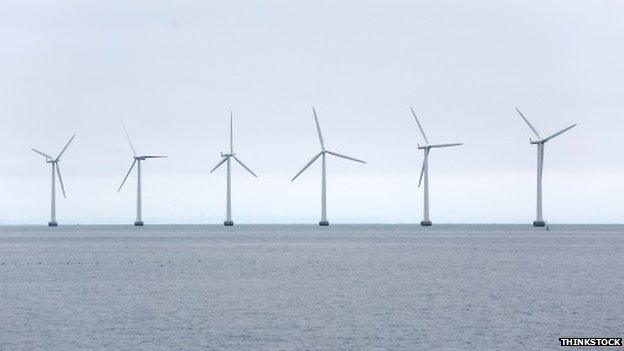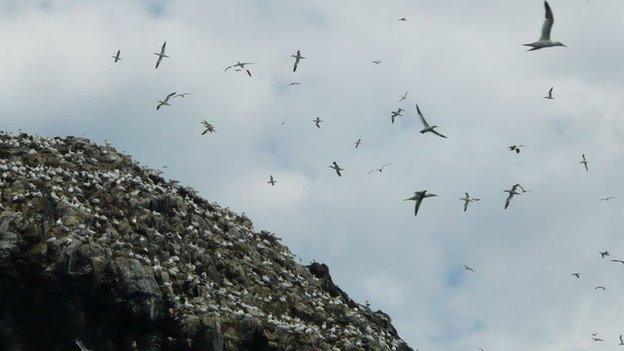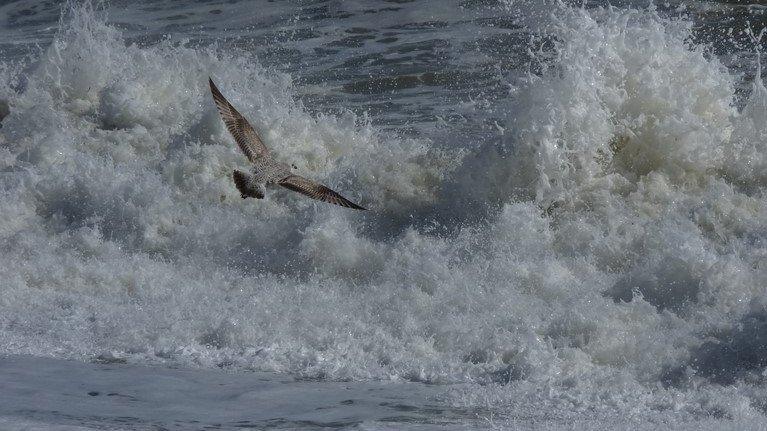Four wind farms off the Tay and Forth win approval
- Published

The turbines off the east coast will be capable of generating enough power for 1.4m homes a year
Four huge offshore wind farms combining hundreds of turbines have been approved off the east coast of Scotland.
The developments in the Forth and Tay region could provide 2.284 gigawatts of power, enough to power over 1.4m homes every year.
Government consent was granted under strict conditions to mitigate any potential environmental impact.
It is estimated the four developments will produce carbon savings of 135m tonnes of CO2 over their lifespans.
While the offshore developments have won the backing of green groups including Friends of the Earth Scotland, the Royal Society for the Protection of Birds Scotland voiced fears over the proximity of seabird colonies.
'Extremely valuable'
The Neart na Gaoith wind farm east of the Fife Ness coastline will have up to 75 turbines, generating 450 megawatts (MW) of power.
The Alpha and Bravo Seagreen developments combined will consist of up to 150 turbines, around 27-38km off the Angus coastline, and could generate 1050MW.
And the Inch Cape development, also off the Angus coastline, will total no more than 110 turbines, generating 784MW.
Energy minister Fergus Ewing said renewable energy was "extremely valuable" to Scotland's economy.
He added: "These wind farms alone could generate a combined gross value added of between £314m and £1.2bn over their lifetime, and generate between 2,567 and 13,612 jobs within Scotland during the construction period.
"I am determined to ensure communities all over Scotland reap the benefit from renewable energy, which will help to reduce climate emissions."
'Huge potential'
The news was also welcomed by Friends of the Earth Scotland, the Crown Estate and Scottish Renewables.
Director Dr Richard Dixon said the approval for the developments was a "big step forward" for Scottish renewable energy.
He said: "Just these four developments could supply two-thirds of Scotland's electricity needs with clean, green energy on windy days.
"These scheme represent as much capacity as Scotland's current nuclear reactors - together with other renewables, these wind farms will ensure we not only meet all of our own demand, but we have a strong surplus of green electricity to export to England, Northern Ireland and beyond."
Ronnie Quinn, lead for energy and infrastructure in Scotland at the Crown Estate, which manages the UK's seabed, said the plans "further cement the UK's position as a global leader in offshore wind".
And Lindsay Leask, senior policy manager at Scottish Renewables, added that the consent was a "massive leap forward" for the Scottish green energy sector.
She said: "This industry has the potential to generate massive amounts of renewable power for homes and businesses and support thousands of new jobs while helping to slash Scotland's carbon emissions."

RSPB Scotland says bird breeding grounds like the Bass Rock could be put at risk by the turbines
'Massive cost'
However, RSPB Scotland expressed "major concerns" over the proximity of seabird colonies to the developments.
Large colonies of gannet, kittiwake, puffin and razorbill breed along the coastlines near the wind farm sites, including the 110,000 gannet colony at the Bass Rock and puffin breeding grounds at the Isle of May.
The society said it was "inevitable" that there would be a decline in species due to seabirds colliding with turbines and displacement from foraging grounds at sea.
RSPB Scotland director Stuart Housden said it was "extremely disappointing" to see approval for developments which "put so many thousands of Scotland's seabirds at risk".
He said: "If the models and assessments of potential damage prove accurate, these windfarms would be amongst the most deadly for birds anywhere in the world.
"RSPB Scotland wants to see the development of offshore wind in Scotland but it must not be at such massive cost to our internationally important seabirds."
- Published2 October 2014

- Published2 October 2014

- Published25 September 2014
